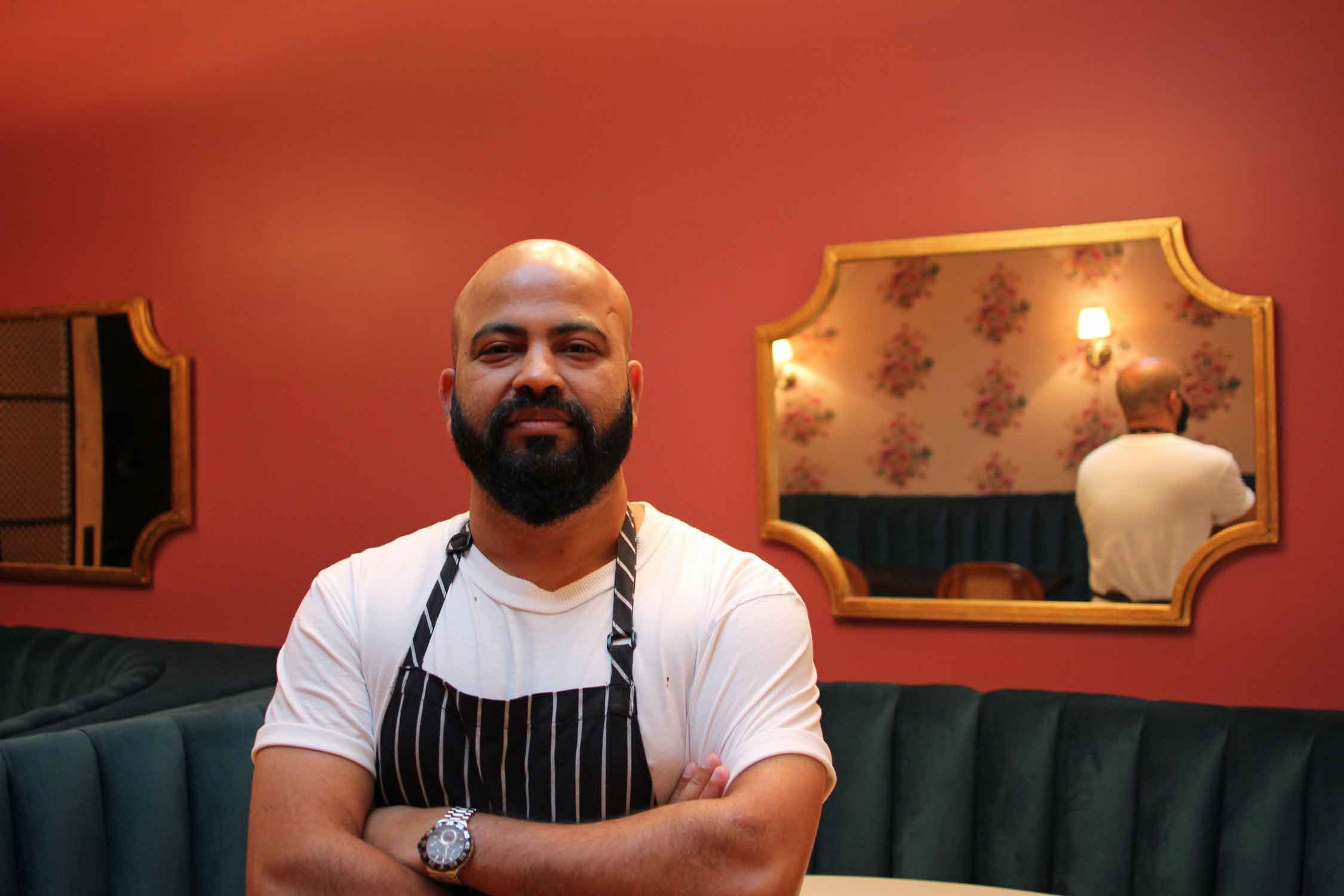AS MUCH AS ANYTHING, YOU COULD attribute the new menu to Michelin’s influence. “I think a lot of people, they’ve eaten at Oriole the night before, or Smyth or Alinea, and they come here with the expectation that it’s a Michelin rated restaurant, and they’re like, this is not the same at all,” says Ryan Pfeiffer, executive chef at Chicago’s iconic Blackbird.
Which it wasn’t meant to be, when One Off Hospitality opened their first restaurant in 1997. Blackbird—stark white, tables close together and kitchen open, busy and sceney like a Paris brasserie—was opened as an alternative to the fine dining experience in Chicago at the time, where the atmosphere was polished, posh and hushed. (Think Trotter, Everest, Tru.) The food, too, was accomplished but unfussy; head chef Paul Kahan had worked for Rick Bayless and Erwin Drechsler and, like them, was an advocate of things that didn’t have names yet, like buying directly from farmers in the midwest and making use of every part of the animal.
But Michelin-clutching tourists from out of town want a luxe experience full of truffles and foie and caviar, which are not exactly… midwestern. (There’s no such thing as Slagel foie. Can you believe it?) A chef can create a $185 reserve tasting menu, full of these internationally recognized signifiers of generic luxury, but will the cost be Blackbird’s soul? Will Michelin’s gravitational suck change you beyond what people know Blackbird to be?
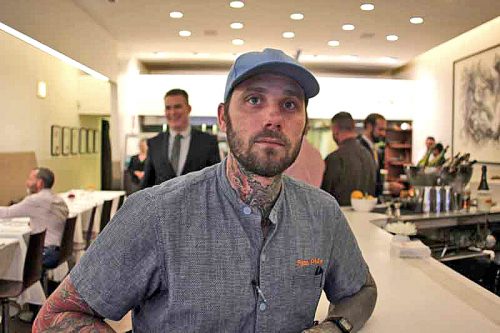
Ryan Pfeiffer at Blackbird
“I like to cook more simple food,” the softspoken, loudly tattooed Pfeiffer says. “But we have a clientele that’s coming in, and it’s 50-50. Some people will come in because they see the Michelin star, and they’ll be, I want to come in and have a Michelin-starred meal. And they say, what the hell is this? This isn’t up to the standard of the Michelin Guide. Well, we’re a one star restaurant, we don’t want to be more than a one star restaurant. We didn’t ask for it. We want to make good food! But if you can’t take a picture of it and put it on Instagram, what’s the point?”
That said, people spending that much money—twice as much as the restaurant’s existing tasting menu—also present an opportunity, if you can find a way to serve them while channeling that revenue into supporting your values.
“I’ve had the pleasure of traveling a lot and cooking at other peoples’ restaurants. I see so many places kind of just, flight of fancy ordering, not knowing where all of their things come from,” Pfeiffer says. “I know this isn’t a new ideology, but Paul had a really close relationship with his farmers when the restaurant was young. It got away from that a little bit, so I’m trying to re-identify with that—the relationship that I and my staff can have with all the ingredients that we’re using.”
Pfeiffer has been in charge of Blackbird since 2015, following Mike Sheerin (who, coming from WD-50 in New York, was the first one to add a tasting menu option and offer “tweezer food” at Blackbird), and then David Posey (who came from Alinea and the like, and brought his own Nordic influences, now on display at Elske). That’s a decade of being fancier than it started under Kahan, but Blackbird’s current “chef’s selection” menu, at $85, is still substantially below the cost of the highest-end menus downtown, which are in the $200 range.
Whenever we taste something, we’re like, “It kind of tastes like a reuben.” If it could be a sandwich, then it’s ready.
The new Friday and Saturday-only, reservations-in-advance-required reserve menu, which is priced at $185, is Pfeiffer’s attempt to meet that kind of Michelin-fed demand for a baller experience, while offering food that supports what he sees as Blackbird’s core mission—respecting the ingredients and nurturing his staff.
“I think the best way to do that is to get stuff in that nobody’s familiar with,” Pfeiffer says. “So we start venturing into the world of different kinds of Pacific Northwest shellfish that we can get in alive, or these box crabs that we were getting in from San Diego. Live urchin that we can get from Maine, or the wide variety of seafood that we can get from Spain. We can get monkfish with the head on, and all the viscera.” (This may not sound that appealing, but monkfish liver has a certain cachet as the foie of the sea.)
“It’s awesome for education, it’s awesome for me and my sous chefs to grow. Everybody gets to see everything, and they all get to ask questions,” he says. “That’s kind of the main focus—to get a closer relationship to the things we’re using, and to know more about them.”
These things, nearly all from the sea, wind up making up the first nine courses of the menu, followed by three from pastry chef Nicole Guini’s team. When I had it in early October, there wasn’t a protein from land until the Slagel duck on the last savory course—a definite difference in approach from the regular menu, which includes a choice between chicken, duck or sirloin, or even the $85 tasting menu, which includes the sirloin. You wouldn’t say it makes for an entirely different experience of Blackbird, but it is a contrast—not least because, like many tasting menus, much of it is cold seafood, assembled out of prepared items, not fresh off a hot grill like a big slab of protein. Blackbird omakase.
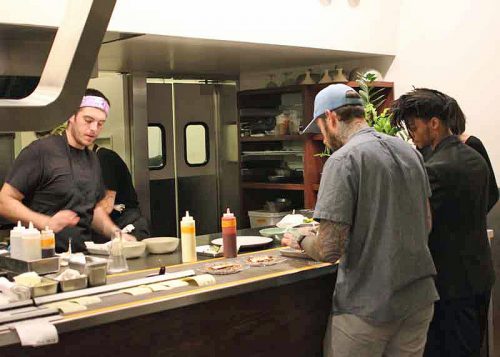
I ask Pfeiffer what the breakdown is on how many people dine each way on Friday and Saturday nights. “On a Saturday, if we do 25 big tasting menus, we’ll probably do 20-25 small tasting menus, and about 60 a la carte covers. So about 40% tasting menus.”
Part of the reason they can do something like the reserve menu is because the world has changed for two-decade-old Blackbird, which opened on the edge of the West Loop when that was like perching on the edge of a canyon. “When I started here, we were very very busy—it was before a million restaurants opened up here in Chicago,” he says. “We would do 200 covers on a Saturday night, and you can’t really source locally for 200 covers.”
Not that Blackbird isn’t busy on the Friday night I go, but Pfeiffer says, “Since things have slowed down a little bit for us, we’re able to put a little more focus on where we’re getting things. It’s good for me, because I get to develop relationships with new people, and I get to pass that on to my sous chefs, who will carry it on. If you know where things came from, you’re going to care more about cooking them. So we like to meet the farmers. It makes it more special.”
He turns philosophical about his new, Michelin and Instagram-tinged reality. “You can’t forget that we’re only here as long as we make people happy. If that’s what they want, then you have to give it to them. If people are going to come in with that expectation, then we have to find a way to make it work for them—in a way that we care about.”
Gallery: Reserve Tasting Menu at Blackbird
As served October 11, 2019
“WHEN I RAN THAT KITCHEN, tasting menus were not so in vogue,” Paul Kahan says. “It’s really happened over the last 10 or 12 years that giant, multicourse menus became all the rage.”
I’m talking to the one-time chef of Blackbird, now the culinary head of a group with a dozen restaurants, by phone as he drives back from the Wisconsin cabin that figures in the concept of his new second cookbook, Cooking For Good Times. It’s built around food from Blackbird’s next door sibling Avec, but it’s framed in terms of the way he likes to eat and entertain at his cabin—which is not multicourse tasting menus.
“For me personally, and this is not a reflection on anyone that chose to do a tasting menu, it’s just not the way that I like to eat,” he says. “I like fewer courses, done really well. For me the dining experience is just as much about who you’re with and interacting with them as it is this reverence for what’s on the plate.”
Sitting there talking with your companions instead of Instagramming each course? Crazy talk! “It sounds like I’m dissing Ryan, and it’s not the case,” Kahan hastens to add. “I leave it 100% up to the chef, the way that they want to run the kitchen. And if it’s important to them to do a tasting menu, so be it,” he says. Of the impetus for Pfeiffer going that way, “I don’t think you can deny it, people grab the Michelin guide and they want to go to all the starred restaurants. Those diners are part of our audience there, but we also have a giant audience of people who’ve been coming to that restaurant for 22 years, and I don’t think they’re tasting menu people.”
Somewhat contrary to the message of his PR people, who wanted to interest me in the reserve menu, Kahan stresses that it’s only one side of his first restaurant as it exists in 2019. “Blackbird is still, I think, the least expensive of all the higher-end restaurants, and I think we’re trying to send the message that outside of that reserve menu, it really is a place that is a little more laid back and a little more casual” than other high end restaurants. Perhaps suddenly conscious of spectral Michelin inspectors raising their noses at the thought, he adds, “That’s a good thing!”
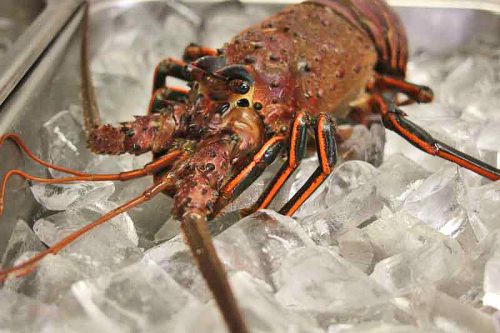
Lobster
“IT’S HARD TO GET PAUL IN for a tasting menu,” Pfeiffer laughs. “He doesn’t really like the idea—he doesn’t like to sit that long. But he’s supportive of it.”
It’s the Tuesday after my dinner, and I’ve eaten the tasting menu, I’ve talked to Kahan, and now I’m in the basement prep kitchen of Blackbird, where Pfeiffer is showing me what was just flown in.
A variety of seafood items rest on ice in pans—some of them in eternal slumber, others yet alive, like the spiny lobster whose feelers twirl around. These are items that Pfeiffer has brought in to play around with for the next day or two—if they come up with a successful dish, it will go on the menu not this Friday, but the next.
He goes through them for my benefit, show and tell. There’s a fish from New Zealand, the sea robin or red gurnard, whose fins fold out spectacularly. And another fish, the John Dory with its famous spot—a fake eye, to fool predators or prey. “It’s a very meaty fish, it tends to hold up to a lot of strong flavors, like other proteins that don’t come from the sea. In Australia, they eat it with wagyu beef,” he says.
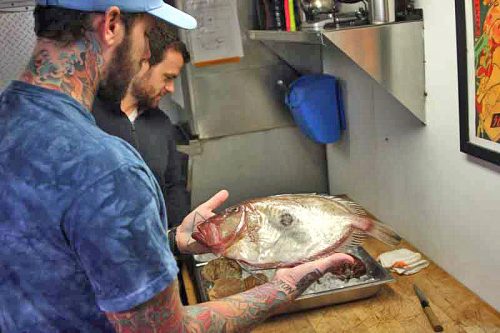
John Dory
Then one of the langoustines, also from New Zealand, which I had had a few nights before. “We’re letting the products stand for themselves. We don’t need to put a thousand different things with an ingredient that’s already really good,” Pfeiffer says. For the langoustine course, “We take half of the heads and steep them in butter. Then we take the other ones and we make a consomme from them, season them like pho. Then we take the langoustine tails and we salt them, then we wrap them in phyllo, and between each layer of phyllo, we brush them with the langoustine butter. Then we cook them so it’s like crispy langoustine, with langoustine broth.
“The emphasis is on the product that we’re spending so much time sourcing and getting in, not on how we can modify it so that it’s unrecognizable,” he says. Paul Kahan couldn’t have said it better.
He pulls out one of the scallops, and quickly shucks it open. “They’re not as good as when we get them from Nantucket,” he observes to one of the other cooks. Then he pulls up the lobster, and describes an idea he has, which involves eventually making a kind of mayonnaise flavored with the head. I note that the final dish sounds kind of like a lobster roll, and he laughs.
“That’s kind of the idea with everything—whenever we taste something, we’re like, ‘It kind of tastes like a reuben.’ Good! Then it’s good to go on. The sandwich theory tends to work out—if it could be a sandwich, then it’s ready.”
“Or a taco,” one of the other cooks observes.

Langoustine
Pfeiffer sets the lobster back in his box. I say something about building a menu around rare ingredients—it sounds a little like the illegal gourmet club in The Freshman, serving komodo dragon serenaded by Bert Parks—but he quickly corrects me.
“They’re not rare. They’re rare for the midwest—getting live langoustines in, getting live sea urchins in, getting a shipment of 20 live king crabs. We have the reserve menu on a reservation-only basis, so that we’re not wasting product. The lives of these animals are not expendable. It’s about respect.
“It’s hard to get things delivered live, all the way to the midwest. It takes a lot of care and it takes a lot of money. And not to be grotesque, but getting in a live animal and having to kill it—it gives people a different perception, especially the cooks, of what’s happening. You’re not getting crab from a can—you watch the life leave this crab’s body, and then you tear it apart.
“Some people look away, some people want to see it happen—it makes it so much more real, what we’re doing. And in the circumstance where you’re super-busy, and you have to cook a thousand things, you’re paying attention more, because you don’t want to make it all for nothing.”
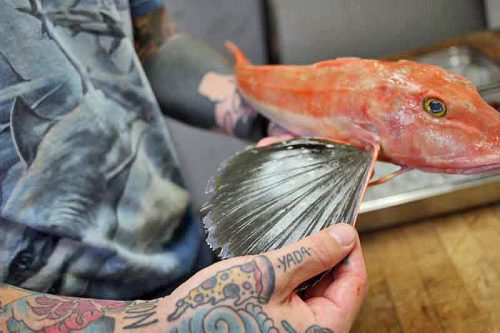
Sea robin, or red gurnard
It’s not something the Michelin Guide-perusing diner will likely think about—most of them would probably prefer not to—but nevertheless, for Pfeiffer this experience and understanding is central to the quality of the meal they will be enjoying. He points to the farmer visits, too, as important for the staff he’s teaching and growing: “Meeting all the different farmers for all the livestock we’re using. Being able to see [the animals] first, and then seeing them come in to the restaurant, and paying attention to how they’re coming in—it changes the perspective of how you cook. You know where the animals are coming from, you know how expensive they are, it’s not like ordering it in bulk and blasting it into the dining room and having unlimited availability.
“But also getting animals that are closer to whole, as opposed to just pieces. It gives us a lot more to play with and a lot more to learn about the process of cooking. It’s important for us to see things out of our comfort zone, so that we can learn how to do them.” He gives an example: “We got this awesome delivery of sardines from Galicia. And you don’t see fresh sardines in Chicago, so we got to learn how to butcher sardines. It’s hard, because they’re so small and so fragile. It… sucks, frankly,” he says. Something those Michelin-following diners will likely never know about their luxurious dinner—but all of Ryan Pfeiffer’s chefs will.
Michael Gebert is the Big Langoustine at Fooditor.
Latest
Join the Discussion
After you comment, click Post. If you're not already logged in you will be asked to log in or register with Disqus.



















